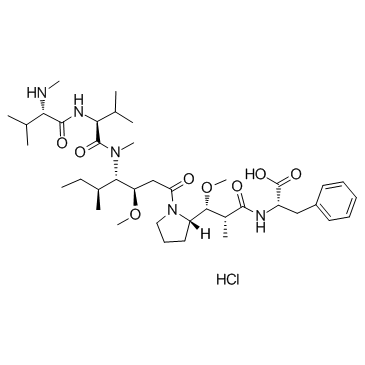MMAF (Hydrochloride)
Modify Date: 2025-08-25 17:49:47

MMAF (Hydrochloride) structure
|
Common Name | MMAF (Hydrochloride) | ||
|---|---|---|---|---|
| CAS Number | 1415246-68-2 | Molecular Weight | 768.42300 | |
| Density | N/A | Boiling Point | N/A | |
| Molecular Formula | C39H66ClN5O8 | Melting Point | N/A | |
| MSDS | N/A | Flash Point | N/A | |
Use of MMAF (Hydrochloride)MMAF hydrochloride is an antitubulin agent that inhibit cell division; inhibits H3397 cell growth with an IC50 of 105 nM. |
| Name | ((2R,3R)-3-((S)-1-((3R,4S,5S)-4-((S)-N,3-dimethyl-2-((S)-3-methyl-2-(methylamino)butanamido)butanamido)-3-methoxy-5-methylheptanoyl)pyrrolidin-2-yl)-3-methoxy-2-methylpropanoyl)-L-phenylalanine hydrochloride |
|---|---|
| Synonym | More Synonyms |
| Description | MMAF hydrochloride is an antitubulin agent that inhibit cell division; inhibits H3397 cell growth with an IC50 of 105 nM. |
|---|---|
| Related Catalog | |
| Target |
IC50: 119 nM (Cytotoxicity, Karpas 299 cell), 105 nM (Cytotoxicity, H3396 cell), 257 nM (Cytotoxicity, 786-O cell), 200 nM (Cytotoxicity, Caki-1, cell)[1] |
| In Vitro | MMAF shows in vitro cytotoxicity against a panel of cell lines. The IC50 values for Karpas 299, H3396, 786-O and Caki-1 are 119, 105, 257, and 200 nM, respectively. Targeted MMAF is much more potent than the free drug, and that cAC10 conjugates of MMAF display pronounced activities. On a molar basis, the cAC10-L1-MMAF4 is an average of over 2200-fold more potent than free MMAF and is active on all the CD30-positive cell lines tested[1]. |
| In Vivo | The maximum tolerated dose in mice of MMAF (>16 mg/kg) is much higher than MMAE (1 mg/kg). cAC10-L1-MMAF4 has an MTD of 50 mg/kg in mice and 15 mg/kg in rats. The corresponding cAC10-L4-MMAF4 ADC was much less toxic, having MTDs in mice and rats of >150 mg/ kg and 90 mg/kg in rats, respectively[1]. |
| Cell Assay | Cells are treated with serial dilutions of test molecules and incubated 4-6 days depending on cell line. Assessment of cellular growth and data reduction to generate IC50 values is done using Alamar Blue dye reduction assay[1]. |
| Animal Admin | Mice: When subcutaneous Karpas 299 tumor size reaches 300 mm3, three animals per group receives one injection of 10 mg antibody component/kg body weight of either cAC10-L1-MMAF4 or cBR96-L1-MMAF4 intravenously. Tumors are then removed and placed in optimal cutting temperature compound, and 5 μm-thin frozen tissue sections are stained using immunohistochemistry evaluation[1]. |
| References |
| Molecular Formula | C39H66ClN5O8 |
|---|---|
| Molecular Weight | 768.42300 |
| Exact Mass | 767.46000 |
| PSA | 166.61000 |
| LogP | 5.01620 |
| InChIKey | BUPKFQQDMNUXOY-KMYLZLQDSA-N |
| SMILES | CCC(C)C(C(CC(=O)N1CCCC1C(OC)C(C)C(=O)NC(Cc1ccccc1)C(=O)O)OC)N(C)C(=O)C(NC(=O)C(NC)C(C)C)C(C)C.Cl |
| Storage condition | 2-8℃ |
| MMAF (Hydrochloride) |